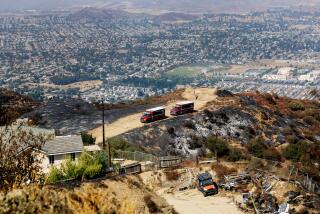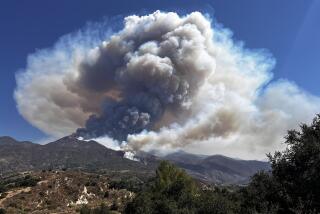A Fight to the Finish in Santiago Canyon
- Share via
With nature’s cooperation, firefighters expect to extinguish the blaze in Orange County’s Santiago Canyon by this morning. Left behind are nearly 8,800 blackened acres and a neighborhood of relieved homeowners.
“We are in the mop-up stage,” said Capt. Scott Brown, spokesman for the Orange County Fire Authority. “It is very important to make sure that everything is cold. As evidenced by the winds this week, it doesn’t take much to fan an errant ember and restart a fire.”
About 1,200 firefighters remained in the area Thursday and had the blaze 70% contained, Brown said. About half of them were expected to work through the night.
Relief and gratitude for firefighters was widespread among residents of the Foothill Ranch community, who had spent several anxious days and restless nights as flames came within 50 feet of homes.
“These are the heroes,” resident Beth Clayton said. “They are incredible human beings, especially to work in this heat.” Now, she said, “We’re just trying to get our lives back together after things being in such a state of upheaval.”
Officials estimated the cost of fighting the fire at $1 million, most of which will be borne by the state, which manages the land, Brown said.
The fire, which had been started by lightning Monday, appeared to be under control Wednesday when a sudden storm carrying 50-mph winds gave it new life. Embers jumped the Foothill Transportation Corridor and ignited small spot fires. At the same time, Marines at the El Toro Marine Corps Air Station, which the Foothill borders, started a backfire to clear brush in the fire’s path.
The toll road and all other streets that had been closed because of the fire were reopened Thursday.
But fire officials said the Foothill had proved an effective firewall that helped block the fire’s spread. In a similar situation last year, firefighters credited the Eastern Transportation Corridor in Orange with helping slow the Baker Canyon fire.
“The reality is that any barrier in place, man-made or otherwise, is good from a fire protection standpoint where it provides a fire break,” Brown said. And obviously, he said, “they serve as good transportation [for emergency equipment].”
In addition, the Transportation Corridor Agencies helped this week by providing water carriers, under an agreement reached last year between it and the Fire Authority.
“It underscores the importance of establishing a cooperative relationship,” Brown said.
While homes were saved this week, however, habitats were destroyed. But environmental experts said that is part of the natural process.
“Wild animals have adapted over time to wildfires,” said John Bradley, a wildlife biologist for the U.S. Department of Fish and Game. “In the long run, that’s the way things happen in this particular biological environment. Things inevitably burn. Typically, burned areas do recover and animals and plants go back to those areas.”
Fire officials will be working with the state Department of Forestry and other agencies to help reestablish the area.
“We will be developing a plan to address environmental issues including how we are going to reseed and rehab the land around Foothill Ranch, which we want to do before winter,” Brown said.
*
Correspondent Jason Kandel contributed to this report.
More to Read
Sign up for Essential California
The most important California stories and recommendations in your inbox every morning.
You may occasionally receive promotional content from the Los Angeles Times.













